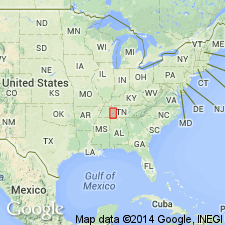
- Usage in publication:
-
- Ross limestone
- Modifications:
-
- Named
- Dominant lithology:
-
- Limestone
- AAPG geologic province:
-
- Cincinnati arch
Summary:
Linden bed is divided into a lower, CAMAROCRINUS or Ross limestone and an upper Pyburn limestone. Pyburn appears to have a greater eastward extension that the lower, overlapping Ross.
Source: GNU records (USGS DDS-6; Reston GNULEX).
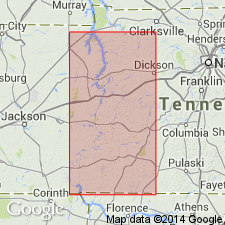
- Usage in publication:
-
- Ross limestone member
- Modifications:
-
- Revised
- Age modified
- AAPG geologic province:
-
- Cincinnati arch
Summary:
Ross limestone member assigned to base of Olive Hill formation. Described as an impure dense fine-grained thin-bedded cherty limestone in layers 2 to 5 in. thick. Hard and compact when fresh. Weathers to soft, porous shaly sandstone of rusty-brown color. Thickness 0 to 80+/-ft. Heretofore regarded as oldest Devonian bed in TN. Unconformably overlies Rockhouse shale (now recognized as basal Devonian) to south, but to north rests on Decatur limestone.
Source: GNU records (USGS DDS-6; Reston GNULEX).
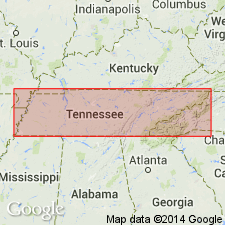
- Usage in publication:
-
- Ross limestone member
- Modifications:
-
- Revised
- AAPG geologic province:
-
- Cincinnati arch
Summary:
Dunbar's classification is modified. Ross formation, which is here defined to include all beds overlying Decatur limestone and underlying Flat Gap or Harriman formations, includes Birdsong shale member, Bear Branch facies, Ross limestone member, Rockhouse shale and limestone members, Decaturville zone, and Bryozoan zone. Author believes that original separation of Pyburn from Ross was not justified, hence name Pyburn limestone is discontinued and all limestone formerly classed as Pyburn is included in Ross limestone member of Ross formation. Ross limestone member, as used here, would be represented at all localities mentioned in preceding work of Foerste, Dunbar, Miser, and Jewell. Ross member conformably overlies Rockhouse shale member in areas along Tennessee River and Horse Creek to south and overlies Rockhouse limestone member in outliers in Hardin and Wayne Cos.; member (and its local Bear Branch facies) unconformably underlies Flat Gap limestone or Harriman formation; northward Ross member grades into Birdsong shale member. Thickness of Ross member in northern part of outcrop area 35 to 45 ft; thickens southward to about 60 ft at Chalybeate Spring and 90 ft along Dry Creek.
Source: GNU records (USGS DDS-6; Reston GNULEX).
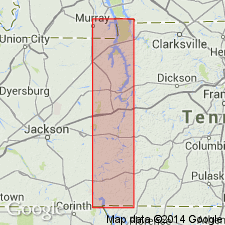
- Usage in publication:
-
- Ross limestone member
- Modifications:
-
- Overview
- AAPG geologic province:
-
- Cincinnati arch
Summary:
Ross Limestone Member is most widespread and best exposed member of Ross Formation within southern facies. Entire thickness not exposed. Minimum of 4.2 m. Age is Early Devonian.
Source: GNU records (USGS DDS-6; Reston GNULEX).
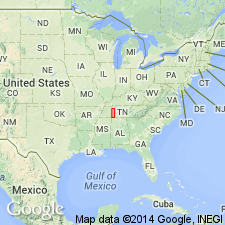
- Usage in publication:
-
- Ross limestone
- Modifications:
-
- Revised
- AAPG geologic province:
-
- Cincinnati arch
Summary:
Field investigation and analysis of Lower Devonian ostracode fauna indicate that the Birdsong Formation, the Rockhouse Formation, the "Rockhouse" Limestone, and the Ross Limestone represent facies of a single depositional episode. The Ross Limestone of this report is correlatable to the Ross Limestone Member of Wilson (1949) and the Ross Limestone and Pyburn Limestone as used by Dunbar (1919). It is a fine-grained, siliceous limestone with mudstone partings and is exposed in the southern portion of the Western Valley of TN. The use of Ross Formation to include the Rockhouse Limestone Member, the Rockhouse Shale Member, the Birdsong Member, and the Ross Limestone Member (Wilson, 1949) should be discouraged.
Source: GNU records (USGS DDS-6; Reston GNULEX).
For more information, please contact Nancy Stamm, Geologic Names Committee Secretary.
Asterisk (*) indicates published by U.S. Geological Survey authors.
"No current usage" (†) implies that a name has been abandoned or has fallen into disuse. Former usage and, if known, replacement name given in parentheses ( ).
Slash (/) indicates name conflicts with nomenclatural guidelines (CSN, 1933; ACSN, 1961, 1970; NACSN, 1983, 2005, 2021). May be explained within brackets ([ ]).

